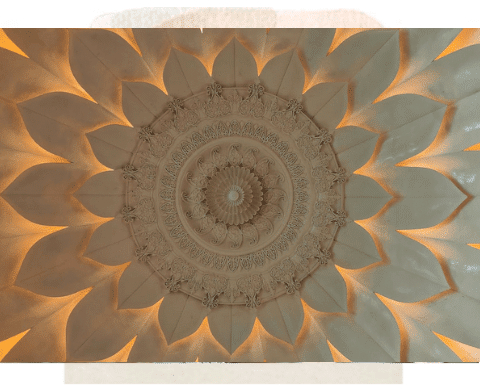How Did You Hear About Us?
Focus of The month

Om asato mā sad-gamaya tamaso mā jyotir gamaya mrtyor mā amrtam gamaya
Om śāntih śāntih śāntih
असतो मा सद्गमय । तमसो मा ज्योतिर्गमय
Brhādaranyaka Upanishad
Lead me from the unreal to the real, from darkness to light, from death to immortality.
Om Peace Peace Peace
~ Translation by Manorama
“See better, Lear”! – The Earl of Kent in King Lear, Shakespeare: Act 1, Scene 1
After he’s told to get out of his sight by King Lear for standing up for Cordelia and speaking the truth, the Earl of Kent urges Lear to see better. Seeing better, clear seeing, looking closely, taking a closer look, so as to see the larger picture, this advice the loyal counselor gives his king is one we find in the teachings of yoga.
The Sanskrit word for looking closely is upekșa (from upa = to go near, toward + ikșa = to look at) – going near to look at. The implied instruction suggests that upekșa is an invitation to see better so that we can engage with our situation with perspective and clarity.
Lear’s capacity to see better, to see clearly was obstructed because he was blinded by stubbornness, pride and power. Stubbornness, pride, power, anger, jealousy, fear, prejudice – the list of obstacles that give rise to our blind spots goes on.
A blind spot is an area in our range of vision that, for whatever reason, goes unseen. Blind spots prevent us from seeing fully, impairing our ability to relate to the immediacy of our experience with perspective and ease. Blind spots are of the realm of avidyā (a= not + vid = to know, feel, experience, recognize). Avidyā means delusion, ignorance, mis-knowing. It refers to a persistent, unrelenting, deep-seated misperception and is the first and root-cause of all the kleshas – wave patterns, interferences, afflictions we get caught up in.
Recently, an Israeli student whom I have known for over a decade said I was the first person he had ever met from the Arab world when he arrived in New York. He shared with me how after some time of sustained yoga practice, the rigid beliefs and fixed ideas of “abstract danger” that he held about “people like me” dissolved, allowing him to realign himself with reality and to “see” me as a person he could connect to with ease rather than with fear.
The āsana practice has many components, one of which is dṛști or gazing point. There are nine dṛștis corresponding to various parts of the body. With the gaze focused in one place, dṛști improves mindfulness and brings about a feeling of oneness – the mind becomes full of one thing, enabling us to experience a moment of full integrity of being.
The process of bringing the gaze to a place of ekāgratā, i.e. single-mindedness on our mat allows us to develop awareness and perception throughout the body. With bodily awareness, we begin to see beyond the limited range of our eyes. We begin to see with feeling. “Every pore of the skin has to become an eye.” writes B.K.S. Iyengar in ‘Light on Life’. When feeling the āsana with each cell of our being, we feel in the present moment, refine our vision, pierce avidyā, and find ease in the body, ease in the mind, ease in our relationships.
The āsana practice invites us to develop sensitivity, so that we can stretch our minds as far as the eye can see, and then takes it a step further by softening what is rigid in our heart so that our vision extends as far as the heart can see. As Antoine de Saint-Exupéry wrote in Le Petit Prince: “It is only with the heart that one can see rightly; what is essential is invisible to the eye.” The mind may guide the body to come into an āsana but the heart has to feel it too. Feeling is the landmark of our human, sentient existence and the dawning of clarity. May we practice so that we can feel the whole of existence in our own being.
TEACHING TIPS
- Share the invocation: ‘Make me an instrument for Thy will; not mine but Thine be done; free me from anger jealousy and fear; fill my heart with joy and compassion.’
As Sharon Gannon reminds us: “this plea invokes the arising of humility and invites us to surrender our small, conditioned self with all of its negative emotions, frustrations, sadnesses and disappointment.” - Use this month as an invitation to reflect on one’s own blind spots. Learn to accept them (which isn’t the same as liking them). With acceptance comes the recognition that we don’t always see the whole picture. This recognition gives rise to humility and clear seeing.
- Teach sequences that explore the 9 dṛștis. If the dṛști indicated for the āsana is too difficult, suggest reverting to the tip of the – nose (nāsāgra dṛști). The list comes from Sharath Jois’ book, Ashtānga Yoga Anusthāna:
– ūrdhva dṛști – up to space
– brūmadhya dṛști – third eye
– nāsāgra dṛști – tip of the nose
– pārśva dṛști – right side
– pārśva dṛști – left side
– nābhi dṛști – navel
– hastāgra dṛști – tip of the middle finger
– angușța dṛști – tip of the thumb
– pādāgra dṛști – tip of the big toe - Explore blind spots in the āsana practice. Suggests movements of arms or legs that disappear from one’s physical eyes and invite students to tap into the sense of proprioception – a felt sense that provides information about the spatial position of different body parts in relation to each other and to the floor and wall planes.
- Ask students to set a timer throughout their day as a reminder to bring their attention to where they are at any given moment. The sound of the timer will serve as an invitation to return to the present moment. This is inspired by a Plum Village Practice (Thich Nhat Hanh’s retreat center and monastery in France) where the “Bell of Mindfulness” rings from time to time during the day as a tool to pause and return to oneself.
- Share with students the practice of Trataka (concentrated gazing), in class or at home, as a way to purify vision and soothe the mind by giving the eyes and mind one thing to focus on. Follow suggestions from The Haṭha Yoga Pradīpika – Chaper 2, verse 31.
- Share the story of Sanjaya from The Bhagavad Gīta, the advisor and charioteer to the blind king Dhṛtarāṣṭra. Sanjaya is a disciple of Sage Vyāsa, who grants him the gift of divya dṛști, or divine vision, which allows him to see distant events in his mind.
- Explore the idea of respect: ‘re’ = again + ‘spect’ = to look. To respect another or a situation means to look again in hopes of seeing more fully or clearly.
* Source for Sanskrit word translation: Inside Patanjali’s Words by Reverend Jaganath Carrera
